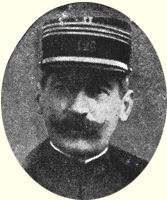Campaign History of the 151e Régiment d'Infanterie - IX
~ 1915 ~
Second Champagne Offensive (1 August - 6 October)
18-22 July: The regiment is at rest at Sainte-Menehould. The detachments of reinforcements that had arrived at Florent on the 14 and 16 of July are now incorporated and the regiment is reconstituted. Over the next several days, a reorganization of the regiment’s command structure. By 22 July, the command structure was as follows:
Staff:
Lieut-Colonel Moisson - regimental commander
Capitaine Chamaillard - assistant to the colonel
Sous-Lieut. Coureaux - flag-bearer
Sous-Lieut. Choisie - officer paymaster
Sous-Leiut. Donsimoni - supply officer
Medecin-Major 1e cl. Idrac
Chef de Musique Hardit
1 Battalion:
Commandant Brugère-Dupuy - battalion commander
Medecin-Aide-Major 1e cl Mr. Ravard
1 Co.: Lieut. Bunoust, Sous-Lieuts. Guilbaud (brevetted to lieut.), de Caqueray, Cahut (transf. from 136 RIT)
2 Co.: Lieut. Bizot, Sous-Lieuts. Royer, Adam (wounded 30 June, returns 20 July)
3 Co.: Lieut. No'l, Sous-Lieuts. Lartigue, Chedal-Bornu, Doumas (transf. from 130 RIT)
4 Co.: Capt. Le Moing, Lieut. Maci, Sous-Lieut. Riton
2 Battalion:
Commandant Adamy - battalion commander
Medecin-Aide-Major 1 cl. Galon
5 Co.: Capt. Joulaux, Sous-Lieuts. Cormier, Guelfucei
6 Co.: Lieut. Giboux (brevetted to capt.), Sous-Lieuts. Bajeux, Aubert
7 Co.: Capt. Layer, Sous-Lieuts. Bertrais, Chartier, Castet-Baron (transf. from 12 RI)
8 Co.: Lieut. Couplet, Sous-Lieuts. Canredon (brevetted to lieut.), Lestienne
3 Battalion:
Commandant Berger - battalion commander
Medecin-Aide-Major 2 cl. Lair
9 Co.: Capt. Grisey, Sous-Lieuts. Salaiin, Le Gallo, Paolaggi (transf. from 49 RI)
10 Co.: Lieut. Destrais, Sous-Lieuts. Mèche, Leymarie
11 Co.: Capitaine Le Boulanger, Sous-Lieuts. Bérail, Metais (transferred from 6 RI, arrives 20 July)
12 Co.: Sous-Lieuts. Marion, Erkeus [sp?], Guillemain
On 20 July, Commandant Moreau is transferred to the 162 RI, while on 21 July, the following NCOs are brevetted as sous-lieutenants:
Adj. Desnoyes assigned to 4 Co.
Adj. Chazot assigned to 2 Co.
Adj. Segaut assigned to 6 Co.
Sgt. Vaisse assigned to 12 Co.
Sgt. No'l assigned to 10 Co.
Sgt. Louvat assigned to 1 Co.
Sgt. Guilhou assigned to 11 Co.
On the same day, at 1130 hrs the 1 Bat. participates in a review passed by chief of general-staff of 3rd Army on the occasion of decorations being awarded. The officers of the 151 are assembled and present themselves to the general commanding the army [Général Humbert].

Regimental band of the 151 RI practicing in Place d'Asterlitz, Ste-Menehould - 24 July 1915. Source: Vallois collection.
23-28 July: Over the course of the next week, two developments occur which arguably affect a fundamental change to the regimental organization. The first is the arrival of multiple detachments of reinforcements originating from other regimental depots. While other units had supplied reinforcements to the 151 before, until this time it had been new recruits and recuperated veterans already assigned to the 151 that made up the lion’s share of replacement troops. As the regiment rebuilds itself after the battering it took in the recent fighting, for the first time a majority of the new troops incorporated into the ranks come from other unit depots (of the total 923 replacements, only 100 come from the 151 depot). The detachments of reinforcements are detailed below.
The second development comes with the structural reorganization of the regiment from the traditional riflemen-dominated unit to a diversified one composed of different specialists. During the same week that the 151 receives and incorporates the replacement troops, the men are organized into groups of specialists and begin their training.
The following reinforcements arrive between 23 and 28 July:
1 sergent, 1 caporal, 82 soldats coming from 16 RI
1 sergent, 3 caporaux, 45 soldats coming from 98 RI
2 sergents-majors, 4 sergents, 16 caporaux, 188 soldats coming from 38 RI
2 sergents, 4 caporaux, 91 soldats coming from 86 RI
2 caporaux, 20 soldats coming from 27 RI
3 sergents, 6 caporaux, 66 soldats coming from 56 RI
2 sergents-majors, 3 sergents, 4 caporaux, 98 soldats coming from 139 RI
3 sergents, 6 caporaux, 141 soldats coming from 95 RI
3 sergeants, 6 caporaux, 91 soldats* coming from the 151 RI
*The entire detachment is incorporated but 48 bad shots are sent to the the battalion depot [presumably for additional rifle training]. The following transfers and brevets also occurred: Sous-Lieut. Fressinet coming from the maréchaux des logis of 1 Corps d’Armée Coloniale. Sous-Lieut. Riton is breveted to lieutenant, while the following NCOs are breveted to sous-lieutenant: Asp. Auguste, Asp. Delbarry (assigned to 3 Co.), Adj.-Chef Daumas, Sgt.-Major Garrigues (assigned to 10 Co.), Sgt. Poussiere.

Generals Humbert (left) and Deville (right) arrive in Ste-Menehould for a review of the 151 RI - 29 July 1915. Source: Vallois collection.
29-31 July:
the reconstituted regiment formally takes arms and Lieut.-Colonel Moisson presents the flag to the regiment assembled on the maneuvering grounds of the Hocquardarie. The colonel commanding 84 BI inspects the regiment at 0630 hrs and General Deville communing 42 DI passes in review at 0730 hrs. General Humbert commanding 3rd Army reviews the regiment which defiles by in column of regiment, the companies in line by section by four. Afterwards, General Humbert passes on his satisfaction at the excellent attitude of the regiment despite the fact that it’s been reconstituted from diverse elements.
On 30 July, the regiment receives orders to make ready to embark during the day. It departs Sainte-Menehold in three trains at 1700, 2000, and 2300 hrs. Stopping at Saint-Hilaire, the regiment bivouacs at the Camp de Chalons at Mourmelon-le-Grand in the Bois de l’Ecole Normale de Tir. The combat and regimental trains are mostly sent to Bouy and the machine-gun company go to Livry-sur-Vesle.
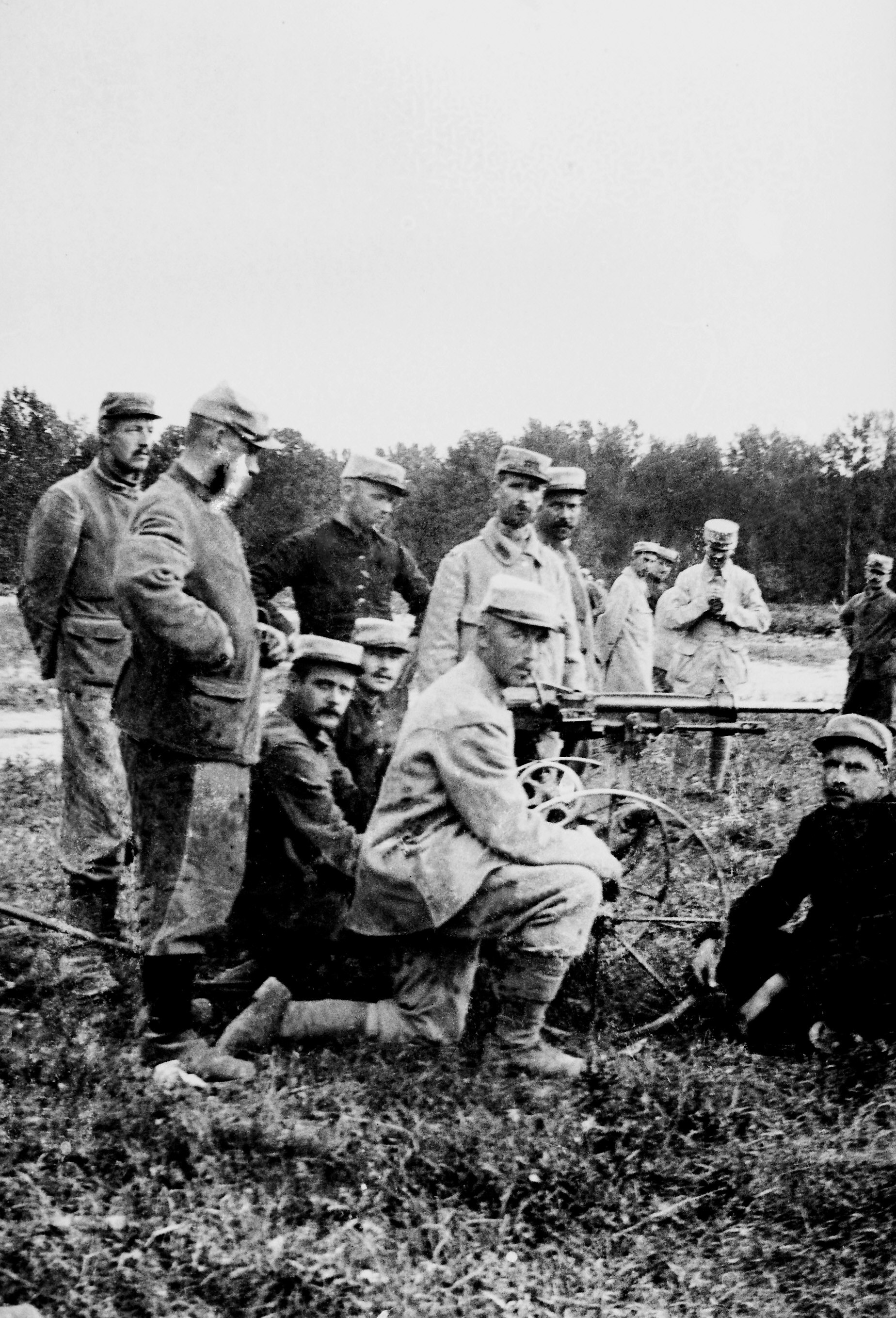
151 RI machine-gun crew in training on 30 July 1915 at Livry-sur-Vesle.
On 31 July, the three battalions arrive successively at their new bivouac site (1 Bat. at 0430 hrs, 2 Bat. at 0700 hrs, 3 Bat. at 0800 hrs) where it must wait for the 21 RIC to leave. In the afternoon, the 151 installs itself and begins to organize its encampment as the elements of the 21 RIC gradually depart.
.jpg?dl=0)
A group of soldiers of the 151e help to extinguish a fire in the village of Sivry, August 1915.
1-17 August: On 1 August, the regiment builds shelters and improves its encampment. In the afternoon, the colonel commanding the brigade and the general commanding the division (Deville) inspect the progress made on the bivouacs. The next day sees the continuation of shelter construction. The regiment is also employed in digging access boyaux to the trenches and evacuation boyaux as prescribed by the Engineers Co. 6/3. In the afternoon, the colonel, along with the battalion and company commanders go off to inspect the works to be dug.
The work is difficult and can only be done during the night. Each company must form into groups of 150 workers, which are to dig ever two nights 150 meters of boyau at 1.75 m in depth and 1.10 m in width, or 120 meters of boyau at 1.40 m in width. The work begins on the evening of 2 August by the 1 and 2 Bats. Work continues on the access boyaux (referred to as Chanzy) every night for two weeks, from 3-17 August. A rotation is set with two battalions going to work at night while one remains at rest -- two nights on, one night off.
The only other events of note include the awarding of Croix de Guerre to 5 officers and 6 soldiers of the 11 Co. on the morning of 15 August. Lieut.-Colonel Moisson is presented with a translate of an article from the Gazette de Francfort [Frankfurter Zeitung] from 3 August 1915 relating the excellent conduct of the regiment at Bagatelle on 2 July, and which paid homage to the heroic death of Commandant Rémy (commanding 3 Bat.).

Frankfurter Zeitung, 3 August 1915 edition, mentioning the actions of the 151 RI and Cmdt. Rémy.
The first chart shows the source where replacement troops (reinforcements) were drawn from for the first half of 1915 before the devastating fighting in the first half of July. The second chart shows the breakdown of replacements coming from the 151 depot who were new recruits versus returning wounded soldiers previously serving with the regiment. The third chart shows the source where replacement troops were drawn from when the regiment was rebuilt after the fighting in the Argonne.
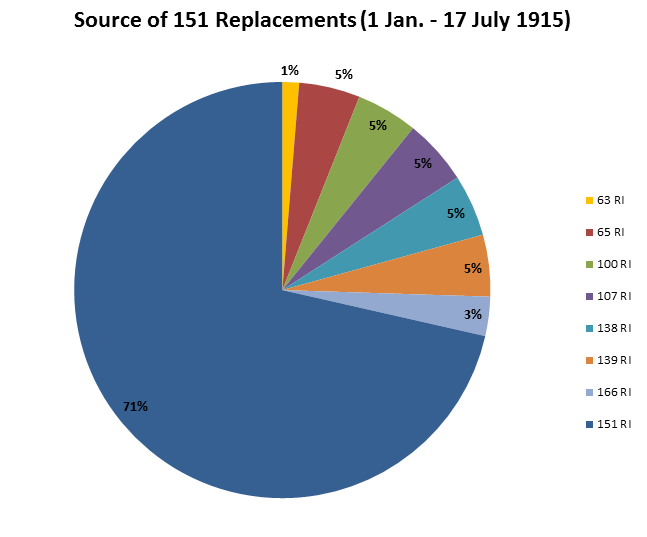
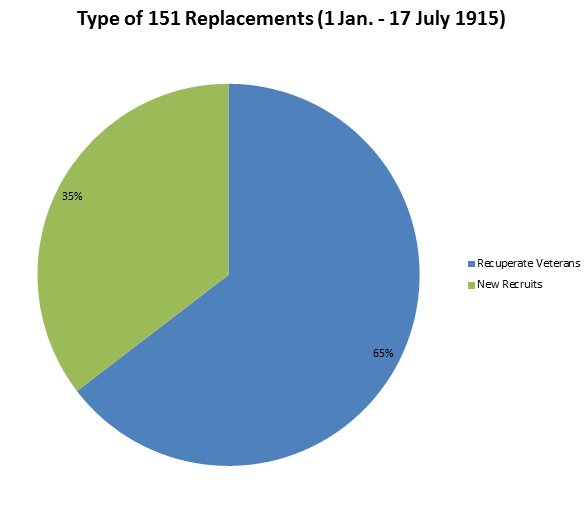
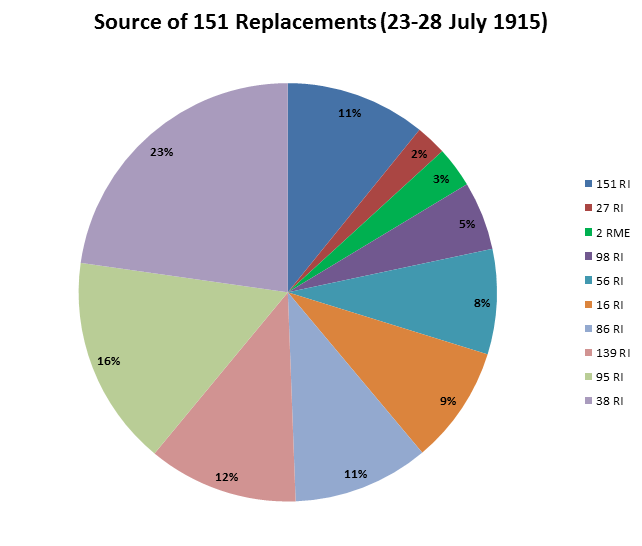
18-31 August: The 3 Reg. de Tirailleurs de Marche takes over the works. The regiment receives departure orders at 0600 hrs on 19 August. The days is spent cleaning the bivouac and making preparations to depart. General Buthelot (commanding 32 CA) inspects the bivouacs at 0930 hrs. The following day, the regiment departs at 0600 hrs and marches until the afternoon with 1 and 2 Bats. billeting at Ambonnay and 3 Bat. at Bouzy. On the morning of 20 August, the regiment leaves its billets and marches 11 km to Plivot [about 30 km south of Reims]. Once there, in the presence of the colonel commanding 84 BI and General Deville (commanding 42 DI), the regiment is proceeded by Colonel Diebold before the flag company for the decoration of the Croix de Guerre of the Army to Capitaine Pernet.
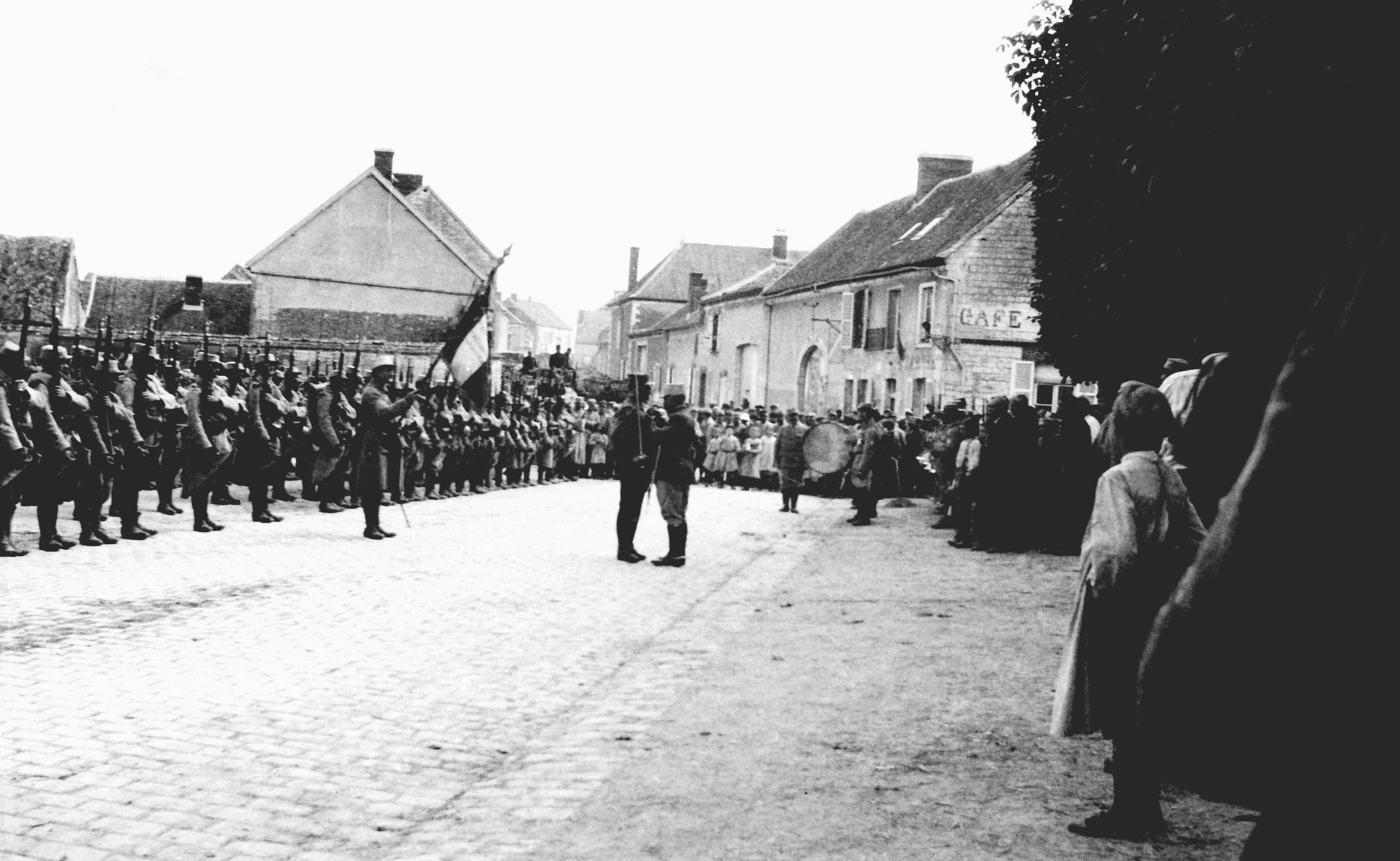
Capt. Georges Elzire Pernet (KIA 20 Sept. 1915) receiving the Croix de Guerre by Col. Diebold at Plivot - 20 August 1915. Capt. Pernet had served with the 151e RI since the very start of the war, first as a lieutenant and supply officer in the regimental staff before being promoted to capitaine and serving as the commanding officer of 3 Company starting in November 1914. He would go on to serve with distinction, being cited in the Orders of the Army for his excellent conduct leading an attack in the Argonne Forest on 17 February 1915. Also featured is a Google image of the same location in Plivot today (location here).
On 21 August, the regiment participates in a defile exercise and review of the brigade under the command of Colonel Diebold in light of a review to be conducted by the entire 42 DI the following day before General Buthelot (commanding 32 CA). This review begins at 0800 hrs (22 Aug.) between Bisseuil and Athis, in formation double columns, the companies in line of sections by four. General Buthelot expresses his satisfaction with the attitude and spirit of the troops. Afterwards, General Castelnau (commanding the center group of armies) addresses the officers of the 42 DI and expresses his satisfaction with the division for its conduct over 7 months in the Argonne.
On the morning of 23 August, the regiments begins a period of instruction. A polygon is set up to the south of the village [Plivot] and the following schedule established:
Reveille - 0500 hrs
Closed ranks exercises [drill] - 0600 to 0930 hrs
Soup - 1000 hrs
Internal duties of the company - until 1300 hrs
Distributions - 1300 hrs
Rest - 1300 to 1400 hrs
Exercises at the polygon (specialists) - 1400 to 1700 hrs
Exercises of the battalion officers - 1400 to 1700 hrs
Soup - 1700 hrs
Music - 1730 to 1830 hrs
Roll call - 2030 hrs
Drum and bugle school - 0600 to 0900 and 1400 to 1600 hrs
Guard relief - 1200 hrs
From 23 August to 28 August, the regimen is carried out. In addition, each of the three battalions takes its turn in conducting a 16 km march on 26, 27, and 28 August, respectively. On the morning of 28 August, Colonel Moisson takes a tour of the new sector the regiment will be occupying.
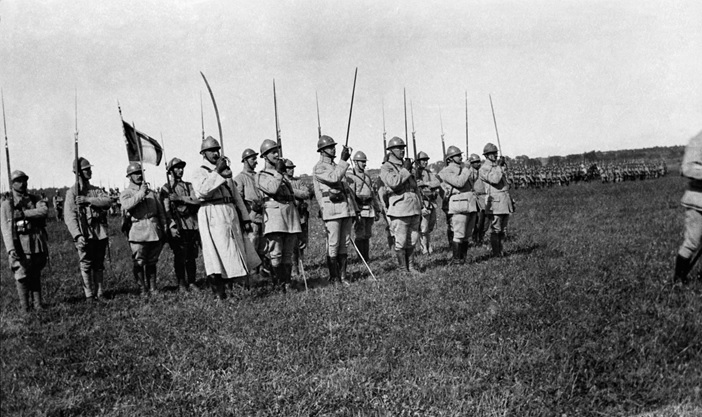
151 RI color guard with Col. Moisson in front, on the left - 29 August 1915.
On 29 August, the regiment celebrates the anniversary of its baptism of fire on 22 August 1914 at Pierrepont. A music reveille is conducted at 0600 hrs and at 1530 hrs the regiment is reviewed by General Deville (42 DI). All the officers and men having participated in the fighting of 22 August are formed and are grouped into the original companies, thus presenting the true veterans of the regiment. At this date, there remain only 16 officers and 303 men (10%) of the original effective that were apart of the regiment on that day one year ago. This original regiment is presented to General Deville, the 151’s old colonel and to the new recruits of the regiment by Colonel Moisson. At 2030 hrs, a torchlight retreat is carried out. The Medaille Militaire is awarded to Adjudant Moreau. Twelve Croix de Guerre are distributed as well as eight gifts from the commander-in-chief [General Joffre].
On 30 August, a final day of training is carried out and then preparations made for departure the following day. The next morning, the regiment leaves Plivot for Aulnay where it remains for the night.
1-10 September: The regiment conducts detail exercises by companies followed by bathing. The next day the regiment departs at 0230 hrs to take up encampments at Camp de Chalons. Marching via Vraux, Bouzy, and Grandes Loges, it covers 21 km in 4 hours. On the night of 3-4 September, 2 and 3 Bats. are put to work on the trenches at Mourmelon. For the next week (till 10 Sept.), the three battalions alternate working on the trenches. Capitaine Paul Maurice Chamaillard is promoted to battalion commander of the 162 RI and is replaced by Capitaine Le Monig. (Chamaillard would be mortally wounded on 25 Sept. 1915, dying of his wounds three days later). Lieutenant Riton takes command of 4 Co. and Lieutenant Lancelot comes to the regiment and is assigned to the same company.
11-21 September: The 2 Bat. remains at rest, while 1 and 3 Bats. depart at 1800 hrs on 10 Sept. for the trenches in order to relieve two battalions of the 94 RI and 107 RI, respectively. The battalions arrive early in the morning of 11 Sept. The battalions set about organizing their positions throughout the day and night. The boyaux and listening posts are extended so as to create a new first line section 150 meters form the old one. Between these two trenches a liaison boyau must be created. Beyond the first line trench a parallel de départ (jumping-off trench running parallel to the front lines) is created. In addition, niche-shelters [i.e. funk-holes] are dug into the different trenches. Losses for the regiment on 11 September include 3 wounded (Sdts. Wous, Rucart, Raffin).
The next day the situation remains the same: continuation of work at day and at night. The positions come under a heavy fire from a German revolver-canon and machine-guns. Losses for the regiment on 12 September include 3 killed and 19 wounded. The casualties recorded in the JMO include:
Killed: Sdts. Robert (Henri), Lepetitdidier, Le Reun, Lemaitre.
Wounded: Asp. Buisson; Sgt. Imbrecht; Cpl. Hursbilck [sp?]; Sdts. Mool, Juimbol, Carpentier, Dejoughe, Bureau, Clabont, Michel, Audiqie, Hubert, Coroy, Moreau, Lecoy, Rousselet, Vaillant, Le Dimet, Bringuier, Dhainaut [mortally], Marchaudise [sp?].
The 13 and 14 September are spent in the same way -- working on the lines while under enemy fire. Losses on 13 September are 5 wounded (Sdts. Gainet, Radde, Godin, Lair, Blane). On 14 September, 1 and 3 Bats. are relieved by battalions of the 94 and 162 RI. Command of the sector is taken up by Colonel Claudon of the 162 RI. The relief is completed by 0130 hrs the next morning. Losses on 14 September are 3 killed (Cpl. Guillise; Sdts. Lequével, Cansu) and 8 wounded (Sdts. Mathieu, Brancourt, Albert (Gabriel), Brossy (Joseph), Breton (Adolphe), Bourtox, Boulot (Louis), Pitault).
The 1 and 3 Bats. return from the trenches at 0430 hrs and occupy the camp left by the 162 RI. The 2 Bat. is sent to continue the work. Losses on 15 September include 1 wounded (Sdt. Grimeau). The 16 September is passed in the same way, with 2 Bat. carrying out exhausting work on the positions. The task is to carry out around 22 km of works. The work requires 6 hours at minimum. Losses on 16 September include 1 missing (Sdt. Fortineua).
On 17 September the 2 Bat. goes up to the trenches in order to take over the entire right sector from a battalion of the 162 RI. Now the 1 and 3 Bats. continue the work every other night. This work consists principally of creating exists in the parallel de depart. Losses on 17 September include 5 wounded (Sdts. Martin, Bar, Le Moign, Geroline, Loeck). The same work carries on the following day as well. Lieutenant Chausson coming from the Quartermaster of 1 CA arrives at the regiment. Losses on 18 September include 2 wounded (Sdts. Peynard [sp?], Martin (Georges)).
On 19 September, the 2 Co. is sent up to the trenches and is placed in reserve behind Selancy's [?] battalion (with a half company placed at the Suippe bridge). Losses on 19 September include 5 wounded (Sgt. Audrist, Sdts. Mince, Ribeyron). The next day, at noon, Colonel Moisson takes command of the sector. Losses on 20 September include 1 wounded (Sdt. Volentin). Work continues on the night of 20-21 September and throughout the next day. Colonel Moisson is relieved by Colonel Gaucher (commanding 83 BI). The 2 Bat. is relieved by the 1 Bat., save 7 Co. which will only be relieved on the evening of 22 Sept. by 2 Co. The 1 Bat. is informed that it will go up to the trenches for good.
22-24 September: The three battalions are all at rest. Preparations are made for the departure to the front. The regiment will attack without packs. The massive preparatory artillery bombardment begins on this day to mark the opening of the Second Champagne Offensive. The bombardment will continue 4 days unabated. Lieutenant Destrais is promoted to capitaine. Losses for the regiment on 22 September include 5 killed (Sdt. Lanoue [sp?], Chapuis, Tordeux, Evrard [sp?], Reguier) and 8 wounded (Sdts. Bertrand (Lucien), Lerouge, Leauthie, Duhaud, Vaudurue, Drot, LevMenn, Dehenne [sp?]), 1 missing (Sdt. Barot). Work continues on the lines the next day, along with more preparations for the coming attack. The violent French preparatory bombardment continues.
On 24 September, departure orders arrive for that evening. The regiment must be in place at 0600 hrs. The heads of the columns must be present at the Suippe [River] at 0200 hrs in the emplacements shown in the accompanying map. The regiment is to be without packs for the assault. The units of the 42 DI are assigned to the Aubérive sector, opposite a portion of the German lines designated as Salient F, on the extreme left (western end) of the French army attack front. The 151 will form the 3rd, 4th, 5th and 6th waves of the attack, the 94 RI and 16 BCP forming the 1st and 2nd waves. The 3 and 4 Cos. of the regiment have been assigned as the flank guard on the right. They are placed under the orders of Commandant de Laubay of the 16 BCP. The intense artillery preparation continues to rage on. Losses for the regiment on 24 September include 2 killed (Sdts. Waltelier, Bigand) and 5 wounded (Sdts. Brochier, Guillet (Albert), Mazet, Seroux, Raby).
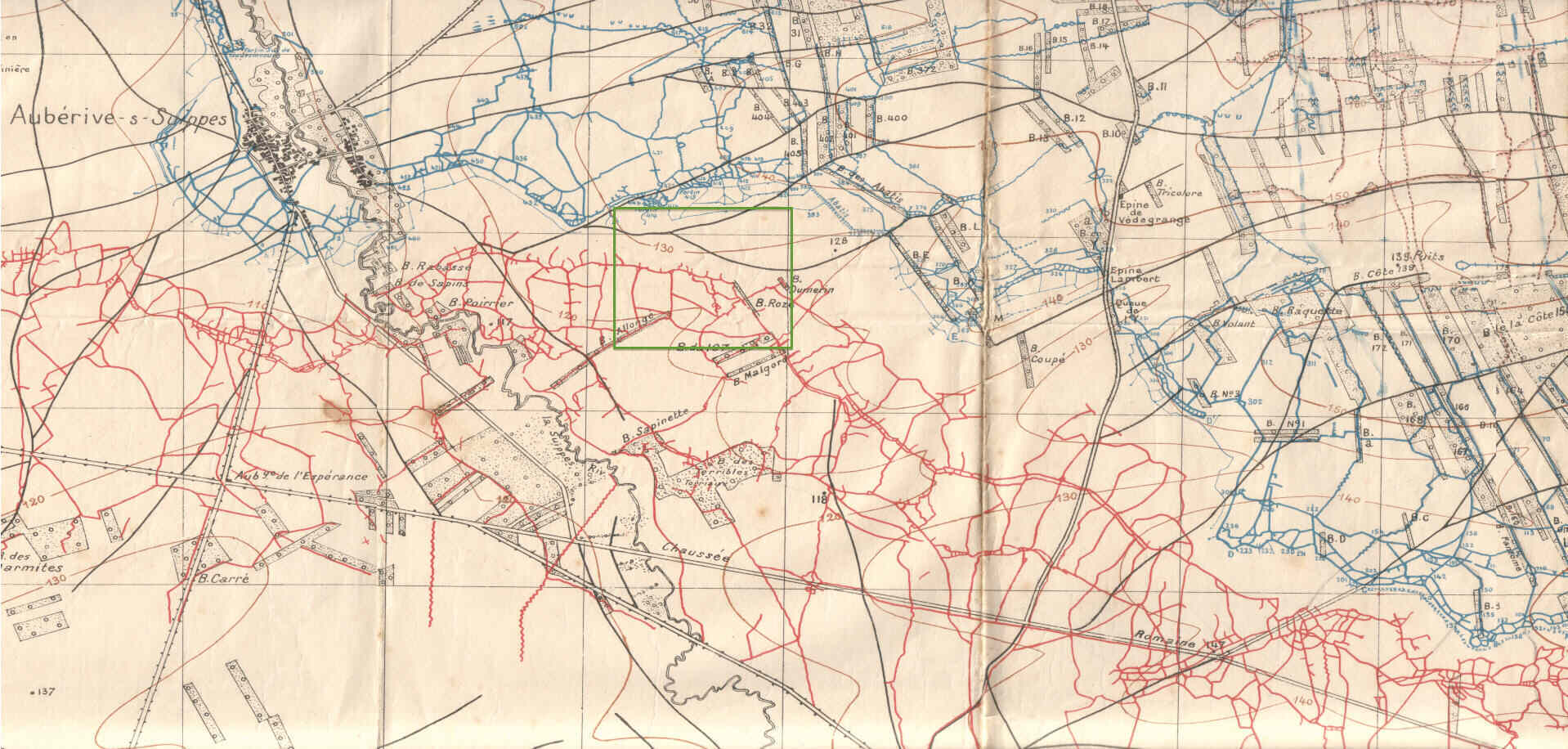
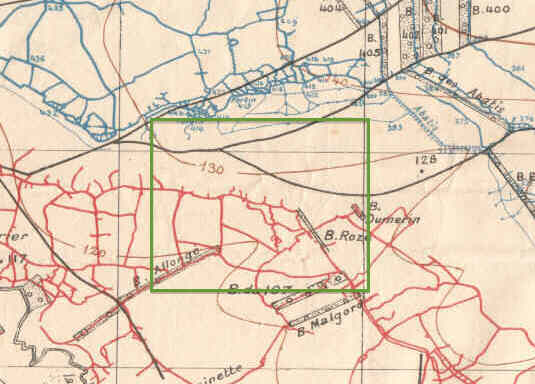
Left: Map of the western end of the Second Champagne front, showing the sectors of Salient F and Salient E, prior to the opening of the attack on 25 Sept. Right: Detail of map showing Salient F sector. Source of map is not known to the author.
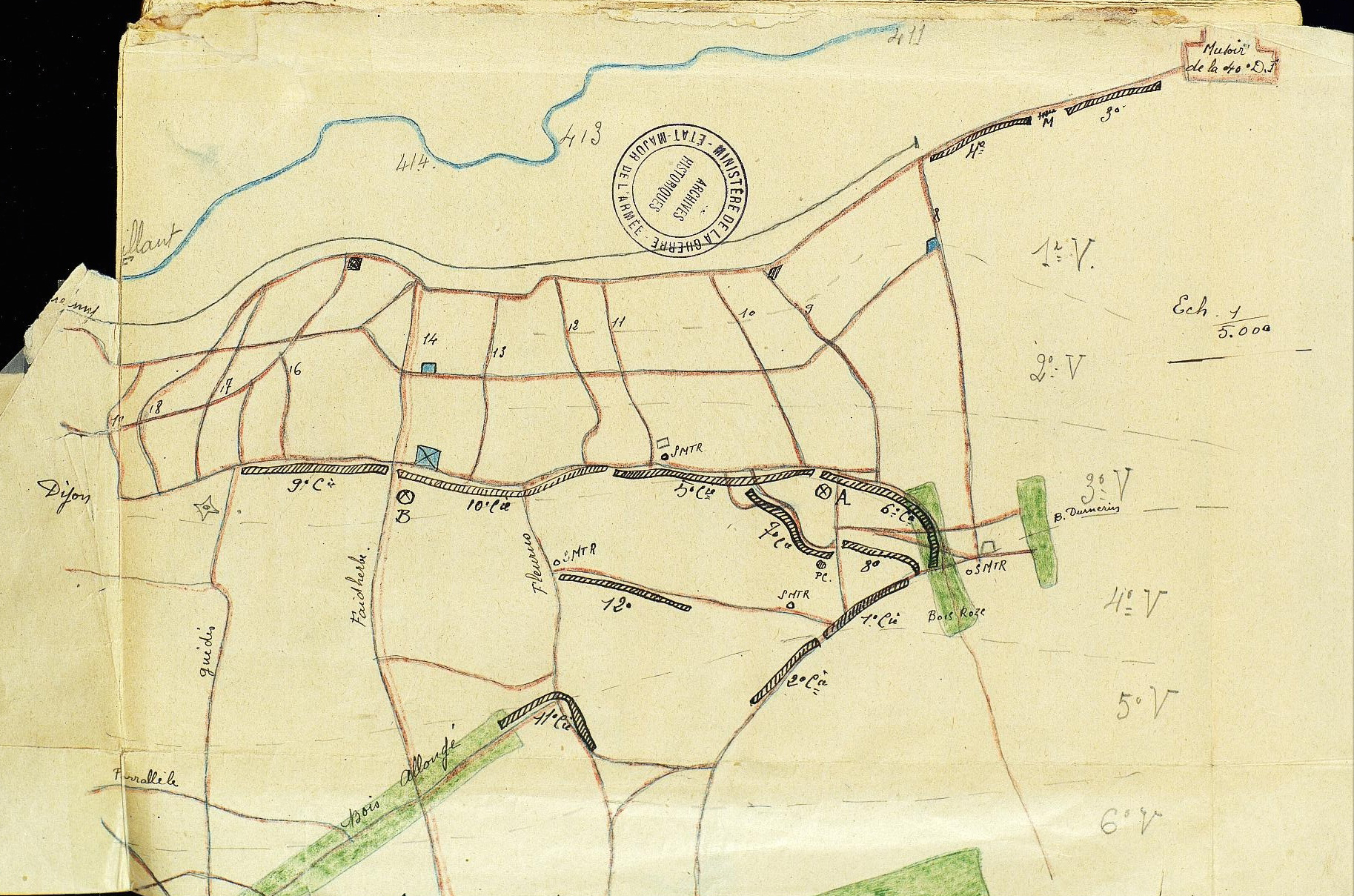
Map from the 151 RI JMO of the Aubérive (Salient F) sector showing the 151's positions on the morning of 25 September. The jumping off positions of the various assault waves (vagues) are marked as well. The names of the paralleles de départ are the two forward-most trench lines shown, corresponding to Tranchées 'Donrémy' and 'Dunkerque'. The first-line trench is labeled 'Dijon', while the boyaux are numbered. A rough outline of the German first-line positions are denoted by the blue line with Salient F located at far left.
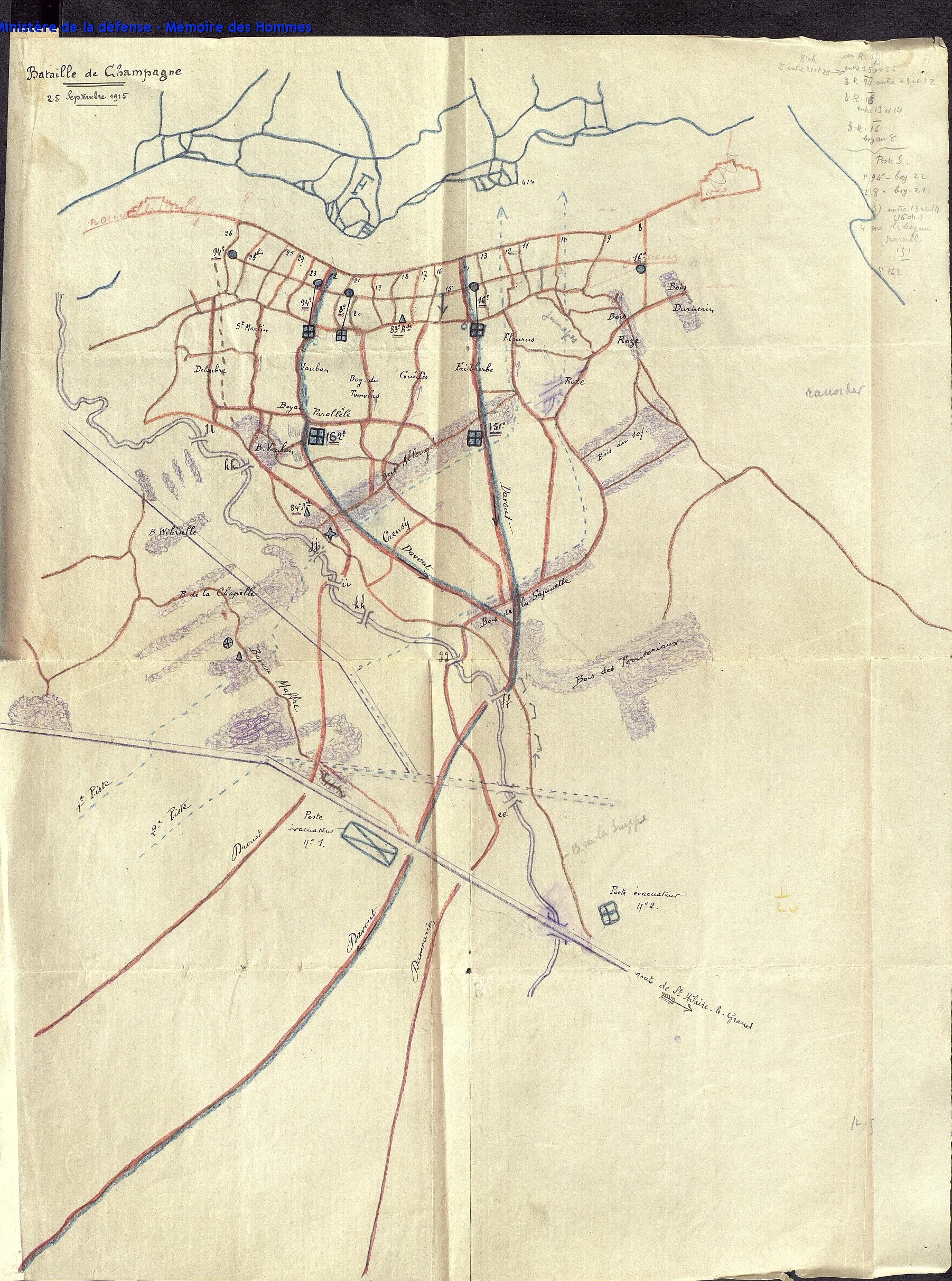
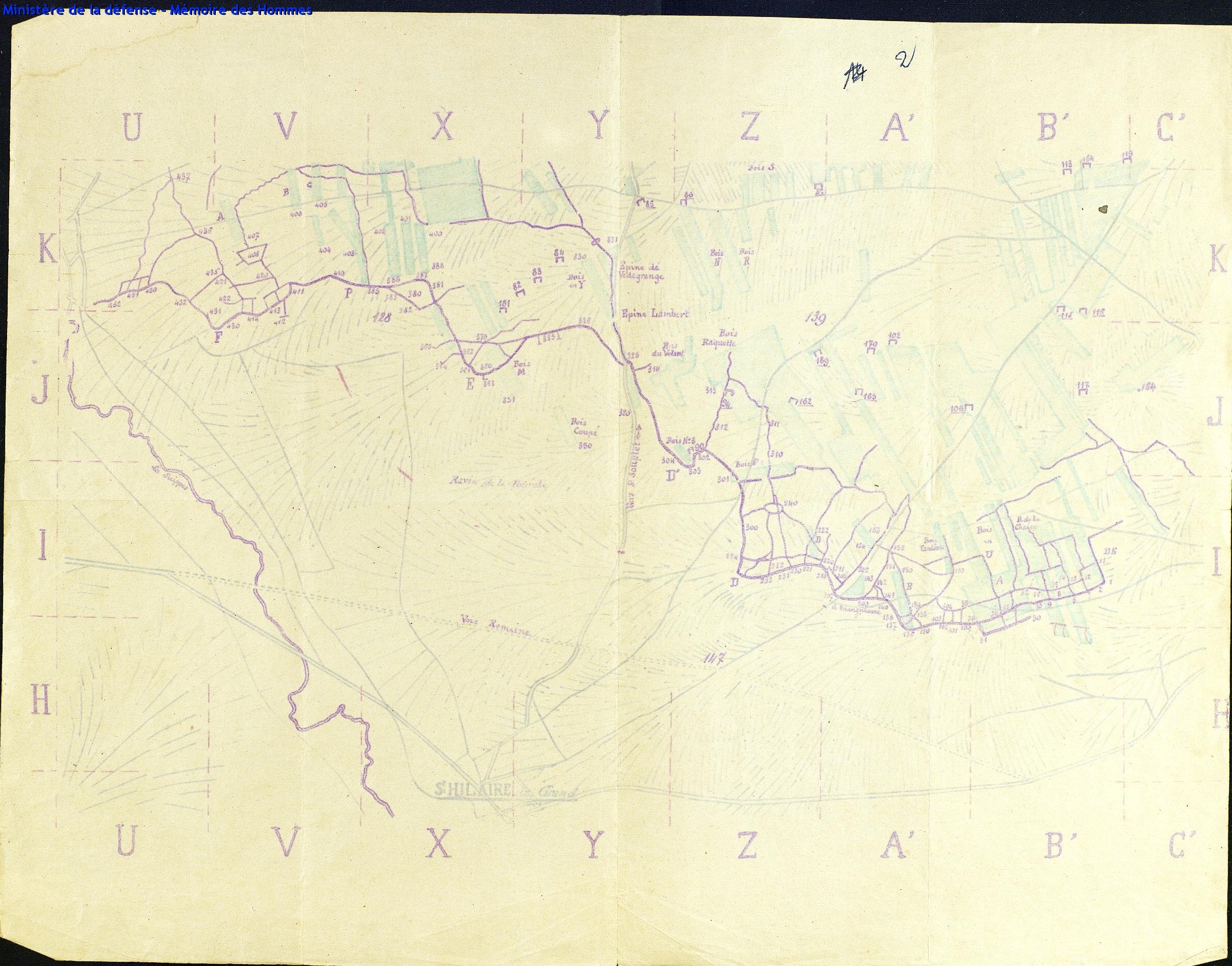
Left: map from the 42 DI Medical Services JMO showing the regimental first-aid and evacuation posts. Right: Map from the JMO of the 103 RI of the Aubérive (Salient F) sector showing German first and second line positions before the start of the offensive. Additional supporting trenches would be dug prior to the French attack.
25 September: In the night of 24-25 Sept., as the French artillery continues to thunder away along the entire 20-mile attack front, the units of the 84 BI take up their positions in the trenches. In the paralleles de départ (Tranchée Donrémy, Dunkerque, and Douai) are the 8 BCP, 94 RI and 16 BCP, comprising the first and second waves of the attack. The 151 RI is behind the 16 BCP and to the right of the organization (occupying Tranchée Dijon), with the exception of the 3 and 4 Cos. which make up the flank guard in the first wave (in Tranchée Donrémy). The 162 RI is behind the 8 BCP and 94 RI, and to the left of the organization. The time set for the attack is 0915 hrs.
All units are in their final positions by 0530 hrs. Starting at 0700 hrs it begins to rain, making the ground very slippery. The preparatory artillery bombardment starts back up very heavy at 0700 hrs until 0800 hrs, recommencing again from 0830 to 0930 hrs. Between 0730 and 0830 hrs, the various assault units condense into their jumping off positions.
In an ominous sign, two minutes before heure-H (zero-hour), the German machine-guns and artillery begin opening up. At 0915 hrs, with bayonets fixed, the first wave goes over the top, composed of the 94 RI, 8 and 16 BCP and 3 and 4 Cos. of the 151 RI on the right. The first objective is fortin ("fortress" or fortified entrenchment) 414 directly to its front. Unbeknowst to most of the French soldiers in the assault waves was that fortin 414, along with a series of other connecting fortins, were heavily armed with German machine-guns in protected positions and 77 mm canons encased in armoured turrets.
The lead assault elements are literally mowed down by German machine-guns and light artillery to the front and flanks. The 94 RI will suffer 1,200 killed and wounded in just the first few minutes of the attack. The next waves depart shortly after the preceding ones, leaving from Tranchée Dijon up to Tranchée Douai and rally the remnants of the lead wave, mixing the units and pushing north toward the German lines. The initial assault waves suffer massive losses as they continue to advance, and then disaster strikes. After covering only a distance of around 100 meters, most of the units run into an intact double belt of barbed-wire. The belt had been placed in hollow in the ground and consequently was left untouched by the preparatory bombardment. The entanglements are 50 meters deep and at shoulder height. They are comprised of barbed-wire intermixed with wire fixed to metal stakes 1.25 meters high. In addition, in front of the high entanglements belts of low wire 30 cm off the ground and 15 meters in depth. But the timetable has been set and the succeeding waves that include the bulk of the 151's companies move up through the boyaux and throw themselves over the top of the paralleles de depart. The result is a horrific fiasco, as the assault waves run straight into the same impenetrable belts of wire and are stopped dead in their tracks, unable to advance into the lethal zone of fire. The JMO of the 84 BI noted:
"The élan of the successive waves of the 151st break upon the German entanglements and are literally mown down by the machine-guns to the front and on the flank. The losses in officers and enlisted are particularly heavy."
All along the regiments front, men try to take cover as best they can in front of the entanglements, flattening themselves against the earth. Those with wire-cutters desperately attempt to cut through in vain and are shot down in the process. The post-war regimental historical would note somberly that entire companies were wiped out in place by strafing machine-gun fire. Whole lines of men lay in front of the wire or macabrely hung suspended in the entanglements.
The second wave formed by the 9, 10, 5, and 6 Cos. of the 151 immediately followed by a platoon of the 7 Co. and two sections of machine-guns move into the parallele de départ at go over the top at 0945 hrs. The two sections of machine-guns take up positions in the Tranchée ‘Donrémy’ [alternately spelt, Domrémy]. The 9 Co. crosses the German first-line around 200 meters west of fortin 414, coordinating its movement with the 162 RI and passing taking over about 200 meters of second German boyau, parallel to the first-line trench. A platoon from the 5, 6, and 7 Cos. advance to the east of the fortin 413 and are forced to halt their advance because of heavy enemy machine-gun and artillery fire. At 1120 hrs, the 12 and 2 Cos. are sent to reinforce them and attempt to push forward the elements of the 6, 4, and 3 Cos. stopped by the barbed-wire entanglements. The machine-gun fire from fortins 414 and 413 and the south corner of Bois 405 is directed onto the top of the parallele de départ, making any exit from it almost impossible. The troops that made it out of the trench are pinned down to the ground at the foot of the entanglement. Around 1230 hrs about fifty Germans leave their trench between 411 and 413 in order to surrender but are carrying large haversacks and their intentions are suspect. After opening fire on them only about twenty come over to the regiment’s trench.
To the 151’s left, the situation was faring better. Here, the French artillery had managed in large part to destroy the German wire-entanglements. Consequently, the 162 RI and 8 BCP make good progress initially, taking their first-line objectives. However, they are unable to advance any further owing to the heavy German machine-gun fire coming from the supporting lines. The same is true along the 42 DI's front: where the wire had been successfully destroyed by French artillery, the infantry initially was able to take the enemy by surprise and progress upwards of 400 meters beyond the German first-line. Beyond the immediate first-line however, the assailants were stopped by the intensifying enemy fire coming from the front and the flanks. At 1330 hrs, the situation is as follows in the right sector where the 151 is situated:
Elements of the 3, 4, 5, and 8 Cos. along with the 2 Co. (which had been sent up as reinforcement) are all stopped dead in front of the wire-entanglements and are unable to move without coming under heavy German machine-gun fire. To the east of Boyau ’11’, the 1 Co. can only advance slowly by crawling in the direction of the entanglements and from there, towards the point where the prisoners had exited. Further to the left, the 12 Co. is also immobilized before the wire and machine-gun fire. The 11 Co. is also stopped by the wire and machine-gun fire in front of Boyau ’16’. There after the company and battalion commanders struggle to reorganize their broken and mixed up units in order to make another push. At 1810 hrs, following a new artillery preparation concentrated on fortin 411 and 413, the elements of the 1 and 2 Bats. that were able to reform renew their attack. Once again however they encounter wire-entanglements still left intact, and in the face of continual fire from the underground German defenses, are unable to make any progress.
In the evening, the 1 Bat. along with the debris of the 2 Bat. reassemble around 2030 hrs in Tranchées ‘Donrémy’ and ‘Dunkerque’, in liaison with 40 DI. To their right, the remains of 3 Bat. also reassemble and are in liaison with the 162 RI. The remnants of 8 and 16 BCP are mixed in among the units of the 151 RI. Engineers Co. 15/5 is put at the disposition of the 151 in order to organize conquered positions. At the close of the first day, the fortins 414 b, 414, 413, and 411 are all intact and remain relatively untouched by French artillery. These fortresses are all found to be armoured and equipped with numerous machine-guns, as well as two armoured turret 77 mm cannons.
Losses for the regiment on 25 September include at least 69 killed, 296 wounded, 450 missing (815 total -- over 25% of its total effective). Due to battlefield conditions, these numbers can only be seen as preliminary. The casualties recorded in the JMO include:
Killed: Co. Hors Rangs: 2 - 1 Co.: 19 (incl Lieut. Bunoust, Sous-Lieut. Fressniet and Louvat - 2 Co.: 15 (incl Sous-Lieut. Delbarry, de Cacqueray, Royer) - 3 Co.: 1 - 4 Co.: 6 - 5 Co.: 4 - 6 Co.: 4 - 8 Co.: 6 11 Co.: 10 - MG Co.: 2.
Wounded: Lieut.-Col. Moisson. Co. Hors Rangs 22 - 1 Co.: 52 (incl Lieut. Chausson and Adj. Morel) 2 Co.: 36 (incl Sous-Lieut Adam and Cahet [sp?]) 3 Co.: 35 4 Co.: 35 (incl Lieut. Riton, Asp. Le Comte) 5 Co.: 23 (incl. Lieut. Cornner [sp?]) 6 Co.: 11 - 7 Co.: 5 - 8 Co.: 20 (incl Lieut. Canredon, Sous-Lieut. Lestienne) 9 Co.: 13 - 10 Co.: 6 - 11 Co.: 9 - 12 Co.: 29 (incl Sous-Lieuts. Guillemin [sp?] and Erkeul), MG Co.: 12.
Missing: Co. Hors Rangs: 5 - 1 Co.: 6 - 2 Co.: 13 - 3 Co.: 85 (incl Capt. Pernet, Sous-Lieuts. Marion and Chedal-Bornu) - 4 Co.: 43 (incl Sous-Lieut Lancelot) 5 Co.: 90 (incl Capt. Jouland, Sous-Lieuts. Gayard and Guelfucei) - 6 Co.: 87 (incl Chef de Bat. Adamy, Capt. Gibou, Sous-Lieuts. Legant and Lecouttere) - 7 Co.: 71 (incl Capt. Payeu, Sous-Lieut. Chartier) 8 Co.: 10 - 9 Co.: 28 (incl Capt. Grisey) - 12 Co.:12 - MG Co.: 2.
26 September: During the night of 26-27 Sept., grenade fights carry on. Meanwhile, the companies are reorganized in anticipation of a new attack to be launched at 0900 hrs. As a precaution in anticipation of a new preparatory bombardment, the troops in the parallele de depart Domrémy are pulled back to the first-line trench Dunkerque. The artillery commences at 0845 hrs on 414 b, 414 and 413. At 0900 hrs, the German fortresses still seem to be relatively undamaged, and coupled with the fact that some units are not yet ready, the attack is postponed to 1000 and then 1200 hrs at allow the artillery to do its work. At 0935 hrs, the 75s fire too short and hit the joining trench that connects to 40 DI positions.
Two tragic mishaps occur in the intervening time before the scheduled heure-H. The first was that the order to delay the attack until noon was not transmitted in time to the 1 Bat., which still believed the original heure-H of 0900 hrs was in place. Consequently, 2 Co. goes over the top. Owing to the continuing French bombardment it soon falls back to its lines having suffered heavy losses. Then at 0935 hrs, the French 75s fire too short and their shells hit the joining trench that connects to 40 DI positions. The second incident
At 1200 hrs, the general attack is launched, composed of the remnants of the 1, 2, 8, 10, 11, and 12 Cos., as well as a half section of the 16 BCP. Once again great élan is shown. The units are immediately taken by a cross fire of machine-guns. The troops arrive at the German entanglements in a single rush but find that it is still not destroyed and even note that new wire had been added during the night to repair the damages. To the left of 414, two sections of 11 Co. leave the trenches with 10 and 12 Cos. The 11 Co. sections find a gap in the wire and push on to the German trench 50 meters to the west of 414 b. However, the 10 and 12 Cos. are stopped by the German wire, which had been repaired by the enemy. The losses are once again heavy, especially among the section leaders. Colonel Moisson attempts to reinforce the 1 Bat. on the left but enemy fire prohibits any movement. No other movements are attempted. German artillery and machine-guns piteously strafe the ground in front of their wire, striking the helpless survivors who lay prone before it.
At night, the regiment sends out patrols to confirm whether the Germans still occupy the trenches around 414 and the answer comes in the form of lively rifle fire. Work parties are organized and the parallele de départ is connected to the German first-line trench. After the attack, Colonel Moisson reports to General Deville "I have made a total effort, there only remain some elements of various companies and pioneers to maintain the security of the front. I’m proud to be able to note that each had squarely done so and that only from incredible difficulties that we were kept from obtaining more success." Indeed the vigor and unhesitating actions of the men had been observed by General Deville and Colonel Diebold and there was no doubt of the courage and sacrifice made.
Transfers: to make up for the losses in the officer cadre, the following transfers are made:
Sous-Lieut. Domars of 5 Co. takes command of the sappers platoon (CHR)
Sous-Lieut. Castet-Baron of 7 Co. takes command of 3 Co.
Sous-Lieut. Garrigues of 10 Co. takes command of 4 Co.
Sous-Lieut. Mèche of 10 Co. takes command of 5 Co.
Sous-Lieut. Guilbaud of 8 Co. takes command of 6 Co.
Sous-Lieut. Bertail of 7 Co. takes command of 7 Co.
Sous-Lieut. Salaiin of 9 Co. takes command of 9 Co.
Losses for the regiment on 26 September include at least 15 killed, 61 wounded, 36 missing (112 total). Due to battlefield conditions, these numbers can only be seen as preliminary. The casualties recorded in the JMO include:
Killed: 6 Co. 1 - 8 Co.: 4 - 11 Co.: 10.
Wounded: Co. Hors Rangs 6 - 7 Co.: 1 - 8 Co.: 13 - 10 Co.: 34 - 12 Co.: 7 - MG Co.: 4.
Missing: Co. Hors Rangs: 5 - 4 Co.: 2 - 7 Co.: 2 - 8 Co.: 2 - 11 Co.: 27.
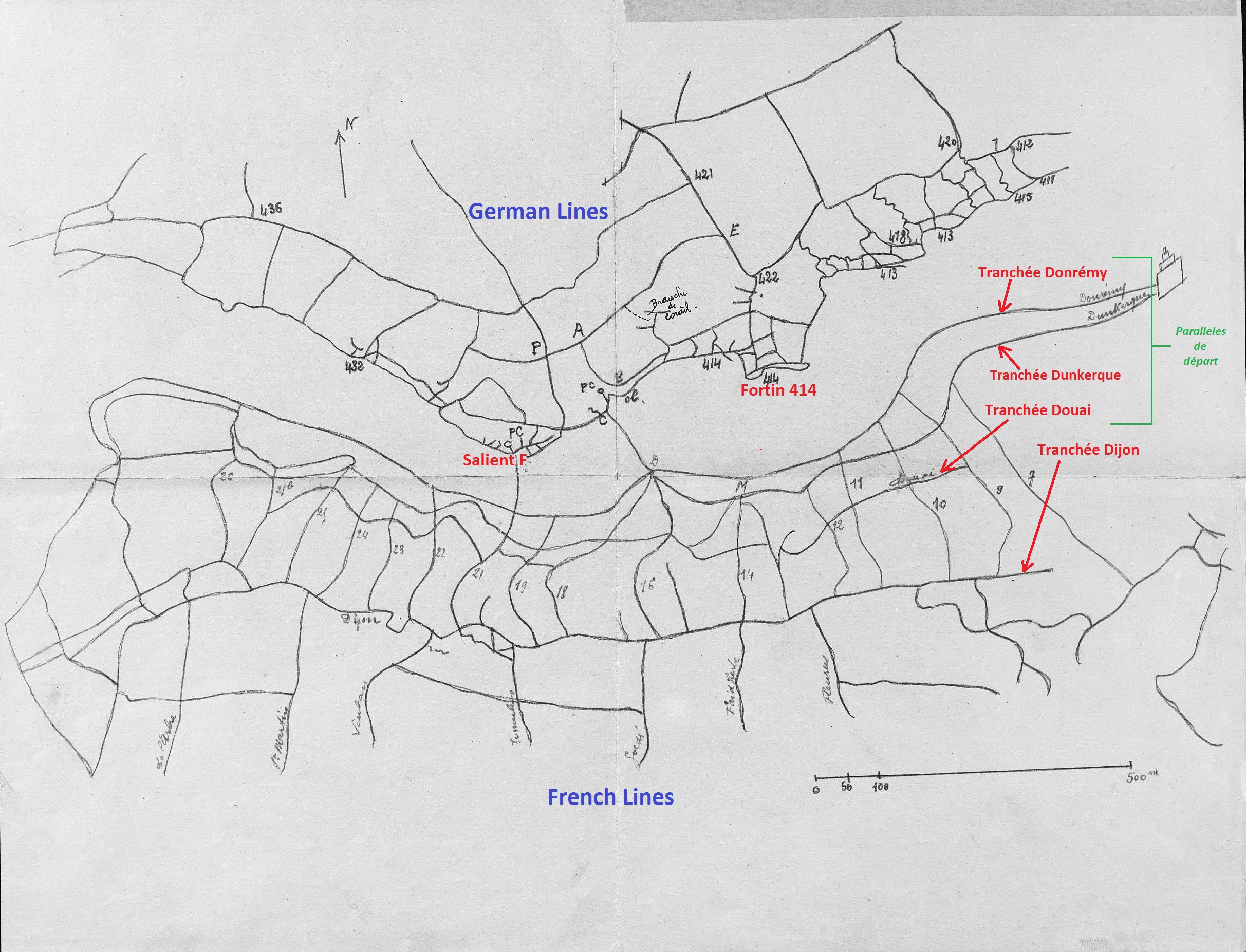
Left: Map from the 151 RI JMO of the Aubérive sector showing the 151's positions on the morning of 27 September. The map more clearly shows the French and German positions in the first days of the offensive. The names of the paralleles de départ are labeled ('Donrémy' and 'Dunkerque'), as is the first-line is labeled ('Dijon'), while the boyaux are also numbered. A rough outline of the German first-line positions are denoted by the blue line with Salient F located at far left. The perpendicular trench lines connecting the parallele de départ 'Donrémy' with the former German first-line trench represent the boyaux dug by the troops on the night of 26-27 Sept. Center and right: aerial photographs of the Aubérive sector taken on 26 October 1915.
27 September: During the night of 26-27 Sept., the Germans continue to bombard the French first lines. The conquered German positions continue to be defensively organized, including the German first-line trench and two boyaux running parallel to the German first-line. No real forward progress can be made in the face of heaving German machine-gun fire coming from fortin 414. At 0630 hrs, they bombard their positions just behind 414 in order to destroy the elements of 3 Bat. which had taken up these positions after an intense fight with hand grenades. During the day grenade fights ensue at the barricades that have been erected. Three machine-guns have been placed for counter-battery fire against the German ones in fortin 414.
It is decided to carry out a raid against 414 at nightfall. The 58 mm mortar is installed and drops 50 bombs on 414. At 1830 hrs grenadiers rush into the German trench just ahead of the mortar barrage but come under machine-gun fire and are forced to withdraw. At night a boyau is dug from the first enemy parallel boyau toward the start of the boyau called 'Branche de Corail'. A patrol is sent out to scout the front to the east of 4141 up to Côte 412 to see if the enemy trench is strongly occupied. This patrol finds the wire-entanglements intact save a few holes upon which the enemy has concentrated its infantry fire.
Transfers: Sous-Lieut. Paolaggi takes command of 1 Co. Losses for the regiment on 27 September include at least 23 killed, 38 wounded, 25 missing (86 total). Due to battlefield conditions, these numbers can only be seen as preliminary. The casualties recorded in the JMO include:
Killed: 10 Co. 12 - 11 Co.: 6.
Wounded: 10 Co. 38 (incl Sous-Lieut. No'l) - MG Co.: 1.
Missing: 10 Co.: 15 - 11 Co.: 10.
In three days (25-27 September) the regiment had lost about 1,000 men and officers. Having started off with a total effective of 54 officers and a little over 2,000 men on 20 September, this represents a loss of roughly half of the entire regiment. Most of these men were killed or wounded in the first several hours (if not the first minutes) of the attack. Ten days later, the regiment was order back into the attack only to meet the same fate as before -- intact belts of wire checked their advance and only caused further slaughter.

28 September: The 151 occupies the original French first-line departure trenches (Donrémy and Dunkerque). German artillery continues its incessant bombardment of the Suippe valley. Patrols are sent out once again. Most of the night is spent reinforcing the trenches and boyaux, reorganizing the conquered trenches, deepening and enlargening the boyau linking the conquered trenches and digging a new boyau linking the conquered trenches with the old parallele de départ. Fortin 414 continues to be shelled by French artillery in order to aid the progression of the troops behind and to the east of 414. Around 1100 hrs a grenade fight ensues between both sides in the same area. German artillery heavily bombards the positions occupied by the regiment with shells of all calibers and poison gas shells. At 1145 hrs, brigade orders the 151 to engage the enemy to the north of 414 and prolong the fight toward the east so as to take the defenders from the rear of the position. In the afternoon, the 162 RI comes up in reserve behind the 151 and occupies the Tranchées Douai and Dijon between Boyaux 7 and 16 up to the left of the sector. One company of the 162 relieves 11 Co/151 RI in the German first parallel boyau. Elements of the 8 and 16 BCP (130 men) still remain at the disposition of the 151. Other portions of the 8 BCP, 16 BCP, and 162 RI move back to the second line to reform after being relieved by the 103 RI. The German artillery bombardment intensifies at 2000 hrs.
Transfers: 1) Capt. Le Monig takes command of 2 Bat.; 2) Médecin Aide Major Berard returns to his post in 1 Bat.; 3) Médecin Aide Major Muikoroski takes up post with the 3 Bat. Losses for the regiment on 28 September include 2 killed and 10 wounded. The casualties recorded in the JMO include:
Killed: Sdt. Mas, Julien.
Wounded: Sdts. Taure, Lannoy, Ballut, Gaulon, Brachelet, Jay (Jean), Andries, Chevallier, Leclerq, Chapeyron.
29 September: The situation remains the same for the 151, which remains in its trenches. Meanwhile, attacks continue to be launched by a battalion of the 162 RI during the night of 28-29 Sept. French heavy artillery bombards the positions behind 414 that are still in German hands to again help the infantry advance and the German heavy artillery responds in kind by shelling the sector. Progression is made difficult by the fire of German machine-guns taking the French trenches in enfilade. At 1600 hrs, the 8 and 16 BCP move to the right sector to provide 500 men as reinforcement for the 151 RI positions. Losses for the regiment on 29 September include 3 killed and 5 wounded (plus 2 chasseurs). The casualties recorded in the JMO include:
Killed: Sdts. Grosjean, Soltan, Deliere.
Wounded: Sdts. Gilbert (Francois), Gilet, Lefebvre (Léonard), Lefèvre (Auguste), Méresse, Auliguae [sp?].
30 September: During the night of 29-30 Sept., the barricade in Tranchée 'H.421' (behind 414) is pushed up 50 meters. The other barricades (in the German first-line trench, Tranchée 'AE', Branche de Corail) have not been owing to the continued German enfilading machine-guns. Between 1030 and 1200 hrs, French 155s and 270s bombard the German positions behind 413 and 414. Starting at 1200 hrs, the 162 RI (1 and 3 Bats.) begins relieving the 151 in the Tranchées Donrémy and Dunkerque. The 151 moves back to the positions the 162 had occupied. Throughout the afternoon, the sector is bombarded with all calibers of shells and poison gas, especially from 1500 to 1900 hrs, as well several times during the night. The units of the 42 DI learn they will be relieved by the 7 DI the next day. The 42 DI will receive less than 48 hours rest before shifting to the right to conduct an attack in another sector. The 151 will be sent to rest at Mourmelon-le-Grand, after which it will report to it's new sector, Salient E, to the northeast of its current sector (Salient F). The night of the 30th is calm in the sector and the time is spent reinforcing the trenches.
A detachment of reinforcements of 498 troops arrives from the divisional battalion including:
Asps. Perrault and Beylard
2 sergent-fourriers
9 sergents
56 caporaux
1 caporal-fourrier
430 soldiers
These replacements are directly incorporated in the trenches. Capt. Le Moing takes command of 2 Bat.
Losses for the regiment on 30 September include 6 killed and 8 wounded. The casualties recorded in the JMO include:
Killed: Sdts. Meunier, Boucler, Rochet, Airiau, Dechem [sp?], Thierry [Alphonse].
Wounded: Sdts. Leseul, Seduler, Saucleme, Faucheux, Ledieu, Coquerel, Chemin, Marbley, Tourmetz.
1-3 October: No change. There's a new heavy bombardment. During the day the men work to clean the trenches. At nightfall, they did the collapsed access boyau, and repair the parapets. At 0030 hrs the 151 is relieved by the 103 RI and goes back to the barracks at Mourmelon. The relief is a very trying one owing to the violent shelling. Losses for the regiment on 1 October include 9 killed and 11 wounded. The casualties recorded in the JMO include:
Killed: Sdts. Guillaume, Vilieret, Guelpa, Guerut, Laignel, Decreux, Larnicol, Peiguot, Gouthier.
Wounded: Sdts. Faucher, Blauchonnet, Doreu, Cocheril, Dupont, Le Gainzier, Massé, Choquene, Voisni, Roussel.
Missing: Auger, Guisembert, Lambecq.
A detachment of reinforcements of 100 troops arrives from the 151 depot comprised of:
Sous-Lieut. Ganot
3 sergents
6 caporaux
91 soldiers
These replacements are incorporated right in the trenches.
On 2 October, the regiment is at rest at Mourmelon. A detachment of reinforcements of 100 troops arrives from the 148 RI depot comprised of:
Adjudant Philippot
2 sergents
97 soldiers
A rapid reorganization of companies is made. Losses for the regiment on 2 October include 1 killed (Sdt. Croizet) and 3 wounded (Sdts. Marlier, Maequet, Beaugrand). The next evening (3 Oct.), at 2000 hrs, the 151 leaves Mourmelon to occupy the left sector of the 40 DI, where it relieves the 150 RI. Losses for the regiment on 3 October include 1 wounded (Sdt. Boutiguies). A detachment of reinforcements of 217 troops arrives from the 151 RI depot comprised of:
Sous-Lieut. Hugon
Asp. Duménil (Dumesnil)
Adj. Albertini
4 sergents
1 cap.-fourrier
12 caporaux
197 soldiers

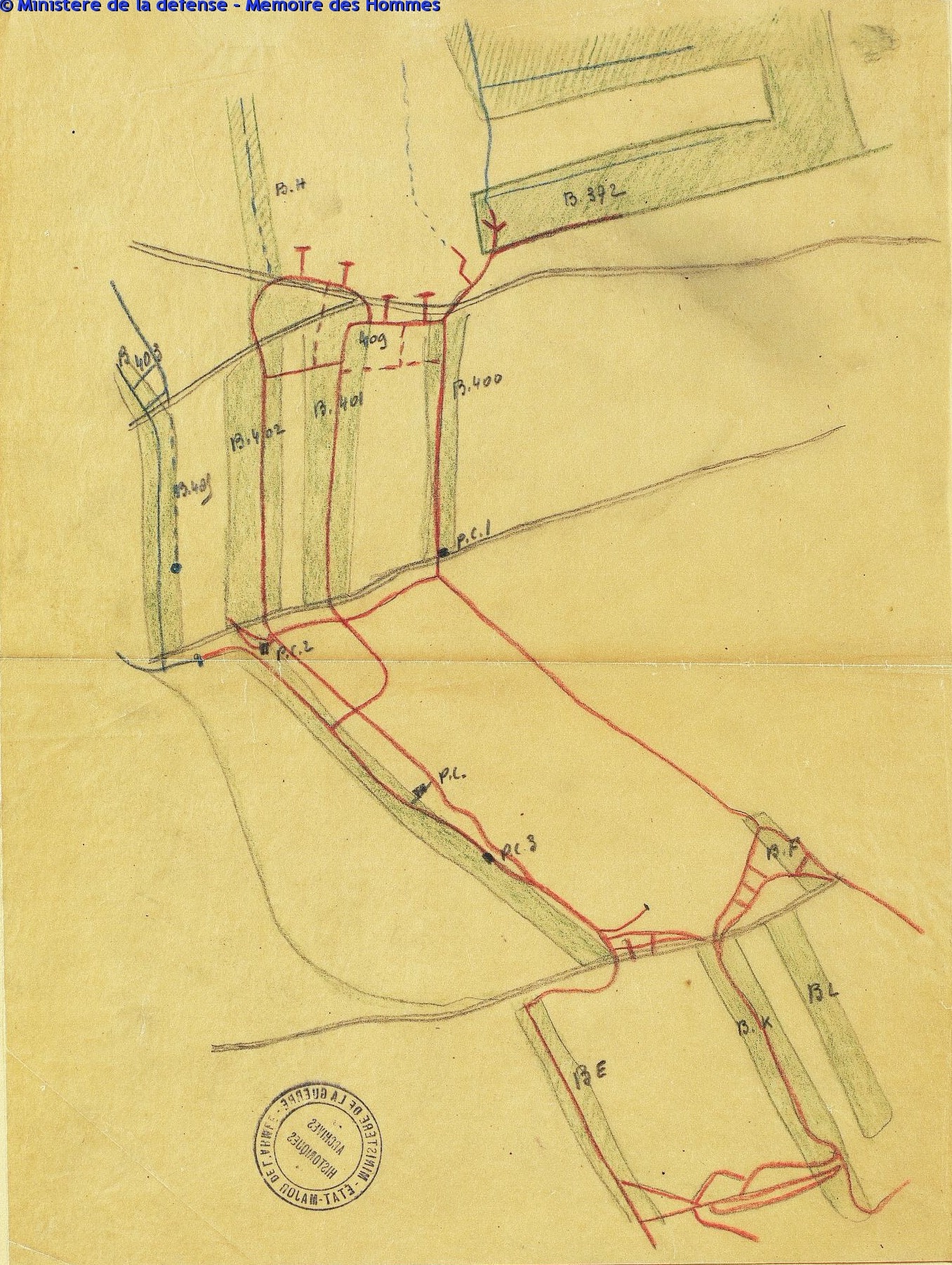
Left: Map of the western end of the Second Champagne front, showing the sectors of Salient F and Salient E (boxed in green), prior to the opening of the attack on 25 Sept. Right: Map from the JMO of the 151 RI showing the regiment's positions on 6 October 1915 in the left sector (Salient E) of the 40 DI. Bois H (B.H.) appears on the top right of the map, Bois 372 to its right (B.372).
4 October: The relief of the 150 RI is complete by 0630 hrs following communication difficulties in the boyaux. The companies take up the positions shown in the map above. From 1600 to 1930 hrs, regiment's entire sector is hit by a particularly heavy bombardment, including a great quantity of asphyxiating gas shells from 1600 to 1730 hrs, which make the trenches almost entirely untenable. This is especially true in the southeast end of the sector. The parapets are greatly reduced and the trenches cave in in numerous places. During the night, the damage is repaired and planning work for a parallele de depart is begun to the south of Bois 372 in view of an attack on this wood. Teams are sent out to cut the wire as French artillery bombards Bois 372. Losses for the regiment on 4 October include 4 killed (Sdts. Marvau, Perbet, Nabat, Longari).
5 October: Situation remains unchanged. The regiment's trenches are strongly bombarded. During the night, the paralleles de depart are partially completed. The 7 Co. is detached to deployment with the 40 DI, joining a platoon of another battalion. Losses for the regiment on 5 October include 6 killed, 20 wounded, and 3 missing. The casualties recorded in the JMO include:
Killed: Cpl. Wilhelm [Robert]; Sdts. Turrodet, Nichon, Lasseigue, Vidis, Carrière.
Wounded: Cpl. Debras; Sdts. Bastide, Meunnier, Treguier, Mathouat, Bordet, Dreuzet, Braudely, Fournon, Caubert, Cuisinier, Vrayet [Odyle], Coltaire, Fleurine [sp?, Maltere, Christophe, Gueguen, Gilis, Vacher, Dormart [sp?].
Missing: Auger, Guisembert, Lambecq.
6 October: The attack in the sector is scheduled for 0520 hrs, with the attack front stretching between Bois 372 on the east to Bois H on the west. The 162 RI is to attack Bois 372 while the 151 RI is to attack the western edge of Bois 372 over to Bois H (included). The 162 RI was to be in place by 0500 hrs, however by 0630 hrs, only the lead elements are in position in front of Bois 372. The 162 RI was to replace in the sector the 3 Bat/151 RI, which itself must go to relieve 1 and 2 Bats of the 151 RI. Due to the situation, this movement can't take place.
Moreover, the 162 RI was to have the head of its regiment at the intersection of d’Ebbe and the Reims Road at 0030 hrs so as to be in place and ready for the attack at 0520 hrs. Yet it had been unable to present the head of its regiment at the PC of Sailient E only at 0317 – this delay was caused by the trouble of navigating the crowded boyaux of the sector. To make matters worse, at 0440 hrs Lieut-Colonel Moisson reported to brigade that the 58 mm mortar battery [under command of Lieut. Martin of the 46 RA], which was to prepare the attack with a bombardment of the enemy entanglements, had not been firing. Moisson requested to know that if the artillery preparation had not occurred, whether he must still order his regiment to attack at 0520 hrs per orders.
Due to the incredible difficulties encountered in the boyaux, only a battalion and half of another 162 RI had not passed the brigade PC at Salient E by 0445 hrs. Due to this delay, brigade pushed the opening of the attack to 0630 hrs to allow for all three battalions of the 162 RI to get into position. Though it was agreed to push off the attack by an hour, the impossibility of circulating in the boyaux prevented a battalion (1 Bat.) of the 162 RI to get into place and participate in the attack. Despite this, the order to delay the attack to 0630 hrs had not arrived in time to the unit commanders in the first line, some units of the 151 and 162 RI begin their movements at the time originally prescribed (0520 hrs).
At 0630 hrs, the three battalions of the 151 RI along with the two battalions (2 and 3 Bats.) of the 162 that were on line go over the top. The JMO of the 84 BI reported that all the battalions carried themselves as if on maneuvers. The assault is initially aided by thick fog. On the right (east), in front of Bois 372, the two battalions of the 162 are stopped dead in front of the German barbed-wire entanglements and chevaux de fries that the artillery preparation had not touched. The Bois 372 doesn’t seem to have been touched by our artillery. Moreover, German machine-guns took the attack waves of the 162 RI by enfilade and prevented any progress forward.
On the left (west), the 3 Bat/151 RI is able to encircle the southwest corner of Bois 372. The 1 Bat. along with elements of 2 Bat. progress to the north of Bois 400, 401, and 402, and manage to take the southern edge of Bois H where they are stopped in front of a belt of impassible barbed-wire entanglement and chevaux de frise. The first elements of 1 Bat/151 are able to advance up to the barbed-wire entanglements located about 120 meters away from the northern edge of Bois 401 and 402. As with the 162, the battalions of the 151 are stopped dead by the wire, and coupled with the murderous machine-gun fire pouring in from the front and flanks, making all forward progress impossible.
In the thick of all of this was Sous-Lieutenant Campana. The young St.-Cyr graduate had been evacuated from the front for a second time on 24 May 1915. Following several months of recovery, Campana rejoined the regiment on 3 October and was assigned to the 1 Co. Before going back up to the front Campana admits that he "more and more has become a fatalist and like the Muslims, I believe that our Destiny is written in advance and that one cannot change the place of exit of our parable of life." Indeed, Campana reported that the men were fully anticipating that it would be a “hot” affair, as they were keenly aware that the German positions they were charged with taking were defended by a veritable sea of barbed wire. The fear of a repeat of the tragic fate which befell the regiment 25 on September 25 was all too great.
Even when the French artillery opened up on the German trenches, the men sensed that the fire was not having the desired effect as they looked out with unease on the enemy wire-entanglements that appeared to remain intact. The minutes slowly counted down until it was time to go over the top.
“The moment has come: a signal from the Captain [Salaiin], a whistle-blow: ‘En avant!’ A bound of 10 meters is made in a disturbing silence, then suddenly a frightful fire of musketry, thousands of bullets whistle by and drill into bodies, shouts of rage, groans, entire lines of blue greatcoats mowed down in place like wooden soldiers and a sudden stop in front of an impenetrable entanglement of barbed wire.‘Lie down!’
We let the bursts of gunfire pass over head. Our artillery starts up again with a more violent fire and the enemy machine-guns stop firing. I look around me; hundreds of men were lying down in skirmish lines in the plain. The Captain gets up:
‘Stand up and about face!’ he cries. Only about 50 men rise, the others remain laying face down in the grass, they were dead.
I shuddered at the sight of all these dead bodies in light-colored greatcoats who would never make another assault. We went back to our departure trench. The Lieutenant [Garrigues] was among the dead. A half-hour later we renew our attack, but still without success. Our Colonel [Moisson], the bravest of the brave, "Father Victory" as the men affectionately called him, came up to ask us to make a third bound. He looked above the parapet and immediately received a bullet in his head; the morale of the soldiers was very affected, but three more times we threw ourselves into the attack again only to break upon the cursed entanglements each time!

Sous-Lieut. Fernand Alphonse Garriguès and Cmdt. François Brugère-Dupuy.
In the fifth assault, the Captain was struck down by a shell fragment and I took command of what remained of the Company. Commandant Brugère [-Dupuy] reassembled the Battalion in the departure trench. The terrorized survivors didn’t want to leave the trench anymore and began to murmur amongst themselves. Their commander exhorted them in vain:‘Are you ready to make another go?’
‘It’s a slaughter!’
‘We’re going to get killed for nothing!’
‘For nothing? No, for France! Come on, one last time!’
‘All right, you go first!’
‘First? Yes, certainly!’The commandant takes his pipe, packs it deliberately and lights it. He takes ahold of his cane with his hand and dashes forward crying: ‘Forward, my boys! This is for France!’
All the survivors dashed forward behind him. He went a dozen meters before collapsing as the bullets rained down like hail, felling a number of soldiers. And for the sixth time I ordered in my turn what remained of the company back to the departure parallel. An adjudant went up to the body of the Commandant, leaned down towards him to see if he was dead or simply wounded, but then collapsed on top of his body. A corporal who crawled up to make the same attempt suffered the same fate. Captain Le Boulanger took command of the Battalion. We were the only officers remaining.
‘Such dishonorable and stupid carnage, I tell you. How do they expect us to take this fort still defended by an entanglement 50 meters deep that hasn’t even the smallest breach and is protected by multiple machine-guns. If we are ordered to attack a seventh time, the men will no longer follow us. It will only serve to get us killed like the Commandant.’
The order to stop the operation arrives several moments later."
Campana's account is backed up by the JMOs of the 84 BI and 151 RI. Lieut-Colonel Moisson did indeed personally direct the attack from a point near the southern corner of Bois H before being shot in the head in the late afternoon. The JMO of the 84 BI records this event at 1530 hrs, where upon command of the regiment was passed to Commandant Berger [3 Bat.]. Worse still, all elements of 1 Bat. which had departed the trenches had become pinned down by German machine-gun fire, the troops hugging the ground in front of the entanglements until nightfall. For the entire day, the boyaux are blocked by the 162 RI. There is also a violent grenade fight at the barricade erected at the southwest corner of Bois 372.
At 1435 hrs, brigade sends orders to the 151 and 162 RI that the 40 DI will be recommencing its attack at 1500 hrs and that units of the 84 BI must cooperate in this attack by taking action against Bois 372, and taking advantage of the 40 DI’s actions by taking ground in the southwestern corner of Bois 372 and the trench to the west of it. In advance of this, the 58 mortars will open a preparation fire. Yet all day long the 58 gun crews were nowhere to be found. In the event, the 40 DI did not open an attack and subsequently the 151 and 162 held off on their attacks.
Back in the 151's original departure trenches, Sous-Lieutenant Campana was only just recovering from the emotional shock of what had transpired. He would record the immediate aftermath of the senseless assaults he and his men had been ordered to carry out.
"Another regiment comes to fill our gaps and the departure parallel is transformed back into a first line trench. But all afternoon the fusillade carried on. The enemy showed a disgraceful conduct: he amused himself for several hours turning our wounded and dead into paste. We listened to the German bullets ricochet off the ground, pierce into helmets or drill into the bodies with a dull thud. At 1400hrs, we perceived over the detonations the wailing, the cries of agony, the groans of our wounded. At 1700hrs, only the creeping of Mausers broke the silence. Between our lines, there were only the dead.According to the JMO of the 84 BI, the attack of the 151 and 162 had been doomed by for three distinct factors: the failure of the French artillery to destroy the German wire, by the presence of enemy machine-gun fire to the front and flanks, and by the narrowness and crowding in the access boyaux, which prevented a battalion of the 162 RI to cooperate in the attack and lead to delays in resupply of munitions for the infantry and the mortars.We imagine the anguish of our poor soldiers pinned down to the earth suffering as they wait from one moment to the next for the bullet that will give them another wound or finish them off. Certain they could not survive this awful nightmare, they found the strength to stand or crawl back toward us. But they didn't get far: the Germans watching them immediately shot them down. When can we give them the same treatment and massacre them without pity!
Our assault had been a complete failure. Who is to blame? Certainly not our leaders, they've done their duty valiantly. Doubtless it's the artillery that could lay waste such an accumulation of defensive accessories, chevaux de frise, barbed-wire, then crush the strongly protected machine-gun nests. Perhaps if the fire had been more accurate?
The morale of the men at this time is dreadful. First, they were happy to learn that the fight was over. Egoism trumping all, they were just happy to still be alive, that mattered most. Then the knowledge of having escaped death seemed entirely natural to them, so they began to occupy themselves with other thoughts. They criticize the operation, outraged by the results. A few headstrong ones knew how to adroitly sow discouragement, and that was especially easy as the soldiers could see in front of them hundreds of dead bodies -- their comrades just the evening before -- lying between the lines, before the inextricable thicket of metal entanglements. They believed they had been sacrificed for no gain and they were bothered by the notion that the thing could be repeated all over again."
At 2045 hrs, division orders the 151 and 162 to hold onto the ground taken and dig a trench where they are. A lively close-quarters fight ensues on the 162’s front between the German and French infantry, calls are sent out support and resupply in cartridges and grenades. Meanwhile, units sent to the support of the 2 and 3 Bats. of the 162, including 1 Bat/162, a battalion of the 94 RI and the 16 BCP, only serve to cause even more of an encumbrance in the boyaux. To help ease the congestion, 1 Bat/162 is sent in reserve behind the 151 in the Bois 400, 401, and 402. At 1200 hrs, the situation is follows:
On the right (east), the 2 and 3 Bats. of the 162 RI are deployed at the southern edge of Bois 372 in their departure trench.
On the left (west), the 1 and 3 Bats. of the 151 RI are deployed to the northern edge of Bois 400, 401, and 402, with some elements having reached the southern edge of Bois H. Two companies of the 2 Bat. have encircled the southwestern corner of Bois 372.
The 1 Bat/162 RI is behind the 1 and 3 Bats. of the 151 RI in Bois 400, 401, and 402, and the 2 Bat. is deployed in Bois 402 facing to the west in order to cover the left flank of the brigade.
At the end the day, the 151 RI is positioned as follows: 3 Bat. at the northern edge of Bois 400; 2 Bat. in Boyau des Abattis; 1 Bat. in the boyaux northwest of Bois B.K. and B.L. Orders are given to erect barbed-wire defenses to the north and northwest fronts, to reinforce as much as possible the first-line, and to push the 58 mm mortars forward so as to destroy the German wire.
The final notes in the JMO of the 151 mentions that the 8 BCP comes up in support to occupy the Bois 402 trench with two companies. Commandant Le Moing in command of 2 Bat. takes command over the remaining elements of 1 Bat. (Le Moing was promoted chef de bataillon). Sous-Lieut. Le Gallo takes command of 9 Co.
Losses for the regiment on 6 October include at least 28 killed, 141 wounded, 61 missing (230 total). Due to battlefield conditions, these numbers can only be seen as preliminary. For instance, we know from Sous-Lieut. Campana's testimony that many men of the 1 Co. were killed and yet the JMO only records the names of 4 Co. KIA. The casualties recorded in the JMO include:
Killed: Cmdt. Brugère, Lieut. Bizot, Sous-Lieut. Garriguès. 1 Co. 4 - 2 Co.: 17 - 4 Co.: 1 - 8 Co.: 2 - 9 Co.: 1 - 11 Co.: 2 - 12 Co.: 1 - Other inf. bat.: 2.
Wounded:




